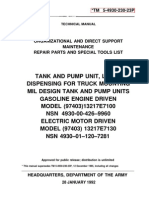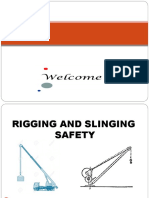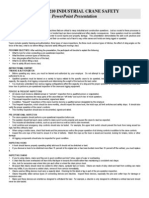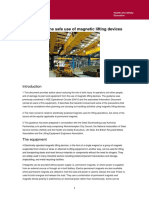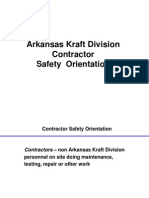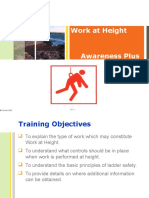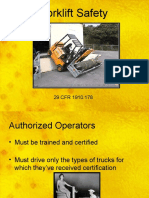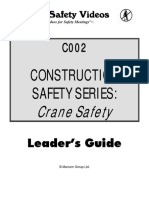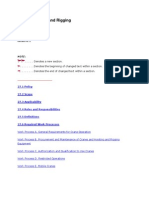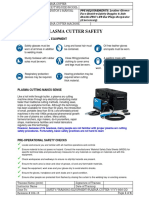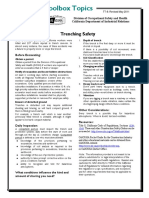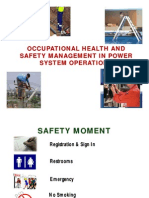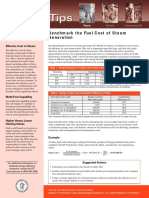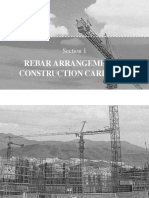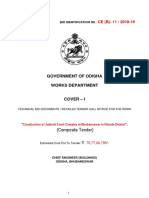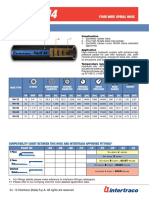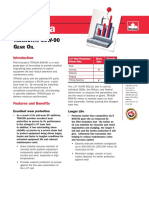Slings-Chains+wir Ropes
Slings-Chains+wir Ropes
Uploaded by
tonyCopyright:
Available Formats
Slings-Chains+wir Ropes
Slings-Chains+wir Ropes
Uploaded by
tonyOriginal Description:
Original Title
Copyright
Available Formats
Share this document
Did you find this document useful?
Is this content inappropriate?
Copyright:
Available Formats
Slings-Chains+wir Ropes
Slings-Chains+wir Ropes
Uploaded by
tonyCopyright:
Available Formats
Slings: Chain, Web, and Wire Rope
Introduction
In technical rescue there is many times where we need to move a load or attach to
it for stabilization, these loads are normally heavy and range from passenger vehicles to
concrete slabs to heavy machinery and everything in between. So that we may perform
these functions safely we use many of the tools used in heavy rigging, specifically slings.
Slings enable us to create anchors, attach to loads, lift loads, pull loads, and lower loads.
The use of slings in technical rescue allows for the safe and efficient mitigation of the
rescue incident.
The dominant characteristics of a sling are determined by the components of that
sling. For example, the strengths and weaknesses of a wire rope sling are essentially the
same as the strengths and weaknesses of the wire rope of which it is made.
Slings are generally one of six types: chain, wire rope, metal mesh, natural fiber
rope, synthetic fiber rope, or synthetic web. In general, use and inspection procedures
tend to place these slings into three groups: chain, wire rope and mesh, and fiber rope
web. Each type has its own particular advantages and disadvantages. Factors that should
be taken into consideration when choosing the best sling for the job include the size,
weight, shape, temperature, and sensitivity of the material to be moved, as well as the
environmental conditions under which the sling will be used for rescue operations chain
and synthetic web slings see the majority of use. While wire rope does have its place in
rescue it is mainly used in winching operations.
Definitions
Angle of loading is the inclination of a leg or branch of a sling measured from the
horizontal or vertical plane, provided that an angle of loading of five degrees or less from
the vertical may be considered a vertical angle of loading.
Basket hitch is a sling configuration whereby the sling is passed under the load
and has both ends, end attachments, eyes or handles on the hook or a single master link.
MCFRS Driver Certification Program Page 1 Aerial Apparatus – Module 6
Braided wire rope is a wire rope formed by plaiting component wire ropes.
Braided wire rope sling is a sling composed of multiple wire rope legs with the top ends
gathered in a fitting that goes over the lifting hook
Breaking Strength/Ultimate Strength Do not use breaking strength as a criterion for
service or design purposes. Refer to the Working Load Limit instead. Breaking Strength
is the average force at which the product, in the condition it would leave the factory, has
been found by representative testing to break, when a constantly increasing force is
applied in direct line to the product at a uniform rate of speed on a standard pull testing
machine. Proof testing to twice the Working Load Limit does not apply to hand-spliced
slings. Remember: Breaking Strengths, when published, were obtained under controlled
laboratory conditions. Listing of the Breaking Strength does not mean the Working Load
Limit should ever be exceeded.
Bridle wire rope sling is a sling composed of multiple wire rope legs with the top ends
gathered in a fitting that goes over the lifting hook.
Cable laid endless sling-mechanical joint is a wire rope sling made endless by joining
the ends of a single length of cable laid rope with one or more metallic fittings.
Cable laid grommet-hand tucked is an endless wire rope sling made from one length of
rope wrapped six times around a core formed by hand tucking the ends of the rope inside
the six wraps.
Cable laid rope is a wire rope composed of six wire ropes wrapped around a fiber or
wire rope core.
Cable laid rope sling-mechanical joint is a wire rope sling made from a cable laid rope
with eyes fabricated by pressing or swaging one or more metal sleeves over the rope
junction.
Center: The center is the axial member of a strand about which the wires are laid. It may
be cotton or polypropylene fiber or one or more wires
Choker hitch is a sling configuration with one end of the sling passing under the load
and through an end attachment, handle or eye on the other end of the sling.
MCFRS Driver Certification Program Page 2 Aerial Apparatus – Module 6
Coating is an elastomer or other suitable material applied to a sling or to a sling
component to impart desirable properties.
Combined Patterns: When a strand is formed in a single operation using two or more of
the above constructions it is referred to as a combined pattern.
Core: The core of a wire rope is the axial member around which the strands are laid to
form a wire rope. It may be either steel, natural fibers, or polypropylene.
Design Factor (sometimes referred to as safety factor):
An industry term usually computed by dividing the catalog Breaking Strength by the
catalog Working Load Limit and generally expressed as a ratio. For example: 5:1.
Filler Wire: This construction has two layers of uniform-size wire around a center wire,
with the inner layer having half the number of wires as the outer layer. Small filler wires,
equal in number to the inner layer, are laid in the valleys of the inner layer.
Hitch is a sling configuration whereby the sling is fastened to an object or load, either
directly to it or around it.
The LAY: The word “lay” is used to describe three physical characteristics of wire rope.
It is both an engineering term and a descriptive term. Lay describes:
1. The direction strands “lay” in the rope – Right or Left. When you look along a
rope strands of a Right Lay rope follow a right-turning pattern. Left Lay is the
opposite.
2. The relationship between the direction strands lay in the rope and the direction
wires lay in the strands. In a regular lay rope, wires lay opposite the direction of
the strand. In a lang lay rope, wires lay in the SAME direction as strands.
3. The length along the rope which one strand uses to make one complete spiral
around the rope core
Link is a single ring of a chain.
Master coupling link is an alloy steel welded coupling link used as an intermediate link
to join alloy steel chain to master links.
Master link or gathering ring is a forged or welded steel link used to support all
members (legs) of an alloy steel chain sling or wire rope sling.
Mechanical coupling link is a nonwelded, mechanically closed steel link used to attach
master links, hooks, etc., to alloy steel chain.
Multiple Operation: When one of the above designs is covered with one or more layers
of uniform sized wires in a different work operation. The second operation is necessary
because the outer layers must have a different length of lay or direction of lay.
MCFRS Driver Certification Program Page 3 Aerial Apparatus – Module 6
The grade of wire will affect such things as strength, resistance to wear, fatigue
resistance, corrosion resistance, etc. The greatest portion of all wire rope is made from
two grades of wire – Improved Plow Steel (IPS) and Extra Improved Plow Steel (XIP).
Both are tough, strong, wear resistant carbon steel, with XIP providing about 15% greater
tensile strength.
Sometimes wire is plated or galvanized before strands are formed, where special
corrosion or wear characteristics are desired. Most wire is “Bright” – that is, without any
surface coating or treatment.
Proof Test Load (Proof Load) The term "Proof Test" designates a quality control test
applied to the product for the sole purpose of detecting defects in material or
manufacture. The Proof Test Load (usually twice the Working Load Limit) is the load
which the product withstood without deformation when new and under laboratory test
conditions. A constantly increasing force is applied in direct line to the product at a
uniform rate of speed on a standard pull testing machine. The Proof Test Load does not
mean the Working Load Limit should ever be exceeded.
Rated capacity or working load limit is the maximum working load permitted by the
provisions of this section.
Reach is the effective length of an alloy steel chain sling measured from the top bearing
surface of the upper terminal component to the bottom bearing surface of the lower
terminal component.
Rope: A number of strands helically laid around a core to form a rope.
Seale: Two layers of wires are formed around the center core wire, with the same
number of wires in each layer. All wires in each layer are the same diameter, and the
strand is designed so that the large outer wires rest in the valleys between the smaller
inner wires.
Standard Rope Classifications
Most common wire rope constructions are grouped into four standard classifications,
based on the number of strands and wires per strand. All ropes of the same size and wire
grade in each classification have the same strength and weight ratings. Ropes within
each classification may differ in working characteristics such as abrasion and fatigue
resistance.
Classification Wires per strand
6x7 7
6 x 19 16 through 26
6 x 37 27 through 49
8 x 19 16 through 26
MCFRS Driver Certification Program Page 4 Aerial Apparatus – Module 6
Selvage edge is the finished edge of synthetic webbing designed to prevent unraveling.
Shock Load results from rapid change of movement, such as impacting, jerking, or
swinging of a static load. Sudden release of tension is another form of shock loading.
Shock loads are generally significantly greater than static loads. Any shock loading must
be considered when selecting the item for use in a system. Avoid shock loads as they
may exceed the Working Load Limit.
Single Layer: Single wire center with six wires of the same diameter around it. It is
called a 7 wire (1-6) strand
Sling is an assembly which connects the load to the material handling equipment.
Sling-To-Load Angle is the horizontal angle formed between the sling leg and the "top"
of the load.
Strand: A strand is a plurality of round or shaped wires helically laid around a center in
one or more layers.
Vertical hitch is a method of supporting a load by a single, vertical part or leg of the
sling.
Warrington: 2 layer construction with uniform sized wires in the inner layer, and two
diameters of wire alternating large and small in the outer layer. The larger outer layer
wires rest in the valleys, and the smaller ones on the crowns of the inner layer.
Wire the basic element of a wire rope is a single metallic wire it may be either round or
shaped
Working Load Limit (WLL) is the maximum load which should ever be applied to the
product, even when the product is new and when the load is uniformly applied - straight
line pull only. Avoid side loading. All catalog ratings are based upon usual environmental
conditions and consideration must be given to unusual conditions such as extreme high or
low temperatures, chemical solutions or vapors, prolonged immersion in salt water, etc.
Never exceed the Working Load Limits.
MCFRS Driver Certification Program Page 5 Aerial Apparatus – Module 6
Safety Precautions
The operator must exercise intelligence, care, and common sense in the selection and use
of slings. Slings must be selected in accordance with their intended use, based upon the
size and type of load and the environmental conditions of the workplace. All slings must
be visually inspected before use to ensure that there is no obvious damage.
A well-trained operator can prolong the service life of equipment and reduce costs by
avoiding the potentially hazardous effects of overloading equipment, operating it at
excessive speeds, taking up slack with a sudden jerk, and suddenly accelerating or
decelerating equipment. The operator can look for causes and seek corrections whenever
a danger exists. He or she should cooperate with co-workers and supervisors and become
a leader in carrying out safety measures - not merely for the good of the equipment and
the production schedule, but, more importantly, for the safety of everyone concerned
Storage
Usage
There are four primary factors to take into consideration when safely lifting a load. They
are (1) the size, weight, and center of gravity of the load; (2) the number of legs and the
angle the sling makes with the horizontal line; (3) the rated capacity of the sling; and (4)
the history of the care and usage of the sling.
Size, Weight, and Center Gravity of the Load
Determining the weight of the load to be lifted, pulled, and/or stabilized is the most
important step in rigging. The capacity of the sling must never be exceeded. After the
weight of the load has been determined then the proper rigging equipment can be
selected.
Properly rigging a load so that it is stable is a critical step. A stable load is one in which
the center of gravity of the load is directly below or in line with the main hook. The
center point of an object is that point at which the object will balance. The entire weight
may be considered as concentrated at this point.
Number of Legs and Angle with the Horizontal:
As the angle formed by the sling leg and the horizontal line decreases, the rated capacity
of the sling also decreases. In other words, the smaller the angle between the sling leg and
the horizontal, the greater the stress on the sling leg and the smaller (lighter) the load the
sling can safely support. Larger (heavier) loads can be safely moved if the weight of the
load is distributed among more sling legs.
Rated Capacity of the Sling:
The rated capacity of a sling varies depending upon the type of sling, the size of the sling,
and the type of hitch. Operators must know the capacity of the sling. Charts or tables that
contain this information generally are available from sling manufacturers. The values
MCFRS Driver Certification Program Page 6 Aerial Apparatus – Module 6
given are for new slings. Older slings must be used with additional caution. Under no
circumstances shall a sling's rated capacity be exceeded.
History of Care and Usage
Mishandling and misuse of slings are the leading causes of accidents involving their use.
The majority of injuries and accidents, however, can be avoided by becoming familiar
with the essentials of proper sling care and usage.
Proper care and usage are essential for maximum service and safety. Slings must be
protected from sharp bends and cutting edges by means of cover saddles, burlap padding,
or wood blocking, as well as from unsafe lifting procedures such as overloading.
When selecting a sling to handle a load, always consider the sling-to-load angle and the
tension that is applied to the sling, as a result of the angle. Slings with adequate work
load limits to handle the “scale” weight of an object have catastrophically failed because
of an inadequate consideration of the sling angle and the resultant tension. Sling failure
results in injury, death and/or property damage. Please rig all loads, responsibly, by
always considering the angle, the resultant tension, and the actual strength requirements
of the sling.
Before making a lift, check to be certain that the sling is properly secured around the load
and that the weight and balance of the load have been accurately determined. If the load
is on the ground, do not allow the load to drag along the ground. This could damage the
sling. If the load is already resting on the sling, ensure that there is no sling damage prior
to making the lift.
Next, position the hook directly over the load and seat the sling squarely within the hook
bowl. This gives the operator maximum lifting efficiency without bending the hook or
overstressing the sling.
Wire rope slings are also subject to damage resulting from contact with sharp edges of
the loads being lifted. These edges can be blocked or padded to minimize damage to the
sling.
After the sling is properly attached to the load, there are a number of good lifting
techniques that are common to all slings:
Guard against shock loading by taking up the slack in the sling slowly. Apply
power cautiously so as to prevent jerking at the beginning of the lift, and
accelerate or decelerate slowly.
Check the tension on the sling. Raise the load a few inches, stop, and check for
proper balance and that all items are clear of the path of travel. Never allow
anyone to ride on the hood or load.
Keep all personnel clear while the load is being raised, moved, or lowered.
Operators should watch the load at all times when it is in motion.
MCFRS Driver Certification Program Page 7 Aerial Apparatus – Module 6
The sling-to-load angle is formed when slings are rigged in vertical or bridle
configurations. As the value of the angle decreases, so does the actual work load limit of
the sling. You can determine whether a sling will have adequate capacity to handle a
given load weight.
1) Calculate the sling-to-load angle
2) Determine the loss factor
3) Multiply the work load limit by the loss factor to determine the actual (reduced) sling
work load limit.
As illustrated below increased load stress is magnified by any change from vertical
toward horizontal lifting. The same stresses are imposed on sling legs when the legs are
attached to the load at various angles.
The result is the actual and reduced work load limit. Sling angles of less than 45Þ should
not be used.
ANGLE "A" LOSS ANGLE "A" LOSS
DEGREES FACTOR DEGREES FACTOR
90 1.000 55 .8192
85 .9962 50 .7660
80 .9848 45 .7071
75 .9659 40 .6428
70 .9397 35 .5736
65 .9063 30 .5000
60 .8660 25 .4226
MCFRS Driver Certification Program Page 8 Aerial Apparatus – Module 6
A BASKET WORK LOAD LIMIT OF 10,000 LBS.
CHANGES AS THE SLING-TO-LOAD ANGLE
CHANGES:
AT 90º-WORK LOAD LIMIT =10,000 LBS.
AT 60º-WORK LOAD LIMIT = 8,660 LBS.
AT 45º-WORK LOAD LIMIT = 7,071 LBS.
AT 30º-WORK LOAD LIMIT = 5,000 LBS.
SLING-TO-LOAD ANGLE
90º 60º 45º 30º
(DEGREES)
10,000 10,000 10,000 10,000
WORK LOAD LIMIT
LBS. LBS. LBS. LBS.
X LOSS FACTOR
X 1.000 X .866 X .7071 X .500
ACTUAL SLING WORK 10,000
8660 LBS. 7071 LBS. 5000 LBS
LOAD LIMIT LBS.
Once the lift has been completed, clean the sling, check it for damage, and store it in a
clean, dry and well ventilated location. It is best to hang it on a rack or wall.
Remember that damaged slings cannot lift as much as new or well-cared for older slings.
Safe and proper use and storage of slings will increase their service life.
RATED CAPACITY (WORKING LOAD LIMIT), FOR ALLOY STEEL
CHAIN SLING;
RATED CAPACITY (WORKING LOAD LIMIT), POUNDS
Double Sling Triple & Quadruple Sling (3)
Single Vertical Angle (1) Vertical Angle (1)
Branch
Chain 30 45 60 30 45 60
Sling
Size, Degrees Degrees Degrees Degrees Degrees Degrees
90
Inches
Degree Horizontal Angle (2) Horizontal Angle (2)
Loading 60 45 30 60 45 30
Degrees Degrees Degrees Degrees Degrees Degrees
1/4" 3,250 5,650 4,550 3,250 8,400 6,800 4,900
3/8" 6,600 11,400 9,300 6,600 17,000 14,000 9,900
1/2" 11,250 19,500 15,900 11,250 29,000 24,000 17,000
5/8" 16,500 28,500 23,300 16,500 43,000 35,000 24,500
3/4" 23,000 39,800 32,500 23,000 59,500 48,500 34,500
7/8" 28,750 49,800 40,600 28,750 74,500 61,000 43,000
1" 38,750 67,100 54,800 38,750 101,000 82,000 58,000
1 1/8" 44,500 77,000 63,000 44,500 115,500 94,500 66,500
1 1/4" 57,500 99,500 81,000 57,500 149,000 121,500 86,000
1 3/8" 67,000 116,000 94,000 67,000 174,000 141,000 100,500
1 1/2" 80,000 138,000 112,500 80,000 207,000 169,000 119,500
1 3/4" 100,000 172,000 140,000 100,000 258,000 210,000 150,000
MCFRS Driver Certification Program Page 9 Aerial Apparatus – Module 6
(1) Rating of multileg slings adjusted for angle of loading measured as the included angle
between the inclined leg and the vertical.
(2) Rating of multileg slings adjusted for angle of loading between the inclined leg and
the horizontal plane of the load.
(3) Quadruple sling rating is same as triple sling because normal lifting practice may not
distribute load uniformly to all 4 legs.
TABLE N-184-2
MINIMUM ALLOWABLE CHAIN SIZE AT ANY POINT OF LINK
Minimum Minimum
Chain Size, Inches Allowable Chain Size, Inches Allowable
Chain Size, Inches Chain Size, Inches
1/4" 13/64" 1" 13/16"
3/8" 19/64" 1 1/8" 29/32"
1/2" 25/64" 1 1/4" 1"
5/8" 31/64" 1 3/8" 1 3/32"
3/4" 19/32" 1 1/2" 1 3/16"
7\8" 45/64" 1 3/4" 1 13/32"
Summary
There are good practices to follow to protect you and all personnel working on the scene
while using slings to move materials. First, learn as much as you can about the materials
with which you will be working. Slings come in many different types, one of which is
right for your purpose. Second, analyze the load to be moved - in terms of size, weight,
shape, temperature, and sensitivity - then choose the sling which best meets those needs.
Third, always inspect all the equipment before and after a move. Always be sure to give
equipment whatever "in service" maintenance it may need. Fourth, use safe lifting
practices. Use the proper lifting technique for the type of sling and the type of load
Chain Slings
Chains are commonly used because of their strength and ability to adapt to the shape of
the load. Care should be taken, however, when using alloy chain slings because they are
subject to damage by sudden shocks. Misuse of chain slings could damage the sling,
resulting in sling failure and possible injury to an employee.
Chain slings are your best choice for lifting materials that are very hot. They can be
heated to temperatures of up to 1000oF; however, when alloy chain slings are consistently
exposed to service temperatures in excess of 600oF, operators must reduce the working
load limits in accordance with the manufacturer's recommendations.
MCFRS Driver Certification Program Page 10 Aerial Apparatus – Module 6
All sling types must be visually inspected prior to use. When inspecting alloy steel chain
slings, pay special attention to any stretching, wear in excess of the allowances made by
the manufacturer, and nicks and gouges. These are all indications that the sling may be
unsafe and is to be removed from service.
Types of chain slings
In describing the type, the following symbols should be used. If attachments are other
than standard, give detailed specifications.
First symbol (basic type):
S - Single chain sling.
C - Single choker chain sling with a standard end link on each end, no hooks.
D - Double branch chain sling.
T - Triple branch chain sling.
Q - Quadruple branch chain sling.
Second symbol (type of master link or end link):
0 - Oblong master link of standard dimensions.
P - Pear shaped master link (available on request, not a standard item).
Third symbol (type of hook):
S - Sling hook
G - Grab hook
F - Foundry hook
L - Latchlok
Sling tags are coded with numerals 1 through 4 to reflect number of branches in sling.
Additional coding is defined as follows:
AS - Adjustable single
SB - Single basket
ES - Endless single
ED - Endless double
SAL - Single adjustable
DAL - Double adjustable loop
AD - Adjustable double
MCFRS Driver Certification Program Page 11 Aerial Apparatus – Module 6
DB - Double basket
CO SOG SOS SGS SSS
Oblong LinkOblong LinkOblong LinkClevis Sling HookClevis Sling Hook
both ends Clevis Grab Hook Clevis Sling Hook Clevis Grab Hook both ends
SGG SOSSL SOCSL SSCSL SGCSL
Clevis Grab HookOblong LinkOblong LinkSling HookClevis Grab Hook
both ends Swivel SafetyClevis SafetyClevis SafetyClevis Safety
Latch Hook Latch Hook Latch Hook Latch Hook
MCFRS Driver Certification Program Page 12 Aerial Apparatus – Module 6
A-SOS-A A-SOS-B A-SOS-SC A-SOCSL-B A-SOCSL-SC
Oblong LinkOblong LinkOblong LinkOblong LinkOblong Link
Eye Grab HookClevis GrabShortening Safety LatchSafety Latch
Clevis SlingHook Clutch Hook Hook
Hook Clevis SlingClevis SlingClevis GrabShortening
Hook Hook Hook Clutch
A-SOSSL-B A-SOSSL-SC
Oblong Link Oblong Link
Swivel Safety Hook Swivel Safety Hook
Clevis Grab Hook Shortening Clutch
Materials:
Carbon Chain – The selection of the base steel is left to the judgment of the individual
chain manufacturer provided the steel meets the following criteria: Carbon, 0.35% max;
phosphorous, 0.040% max.; and Sulfur, 0.050% max.
Alloy Chain – The selection and amounts of the alloying elements in the steel are left to
the judgment of the individual chain manufacturer provided the steel meets the following
criteria: Carbon, 0.35% max.; phosphorous, .035%% max.; Sulfur, 0.040% max. Nickel
must be present in an alloying amount (0.40% min.), and at least one of the following
elements must be present in an alloying amount: Chromium (.40% min.) or Molybdenum
(0.15% min).
Stainless Steel Chain – The material must be a 300 series austenitic stainless steel.
Welding Process – Steel chain shall be made by electric welding or gas welding process.
MCFRS Driver Certification Program Page 13 Aerial Apparatus – Module 6
Alloy steel chains
Welded alloy steel chain slings shall have permanently affixed durable identification
stating size, grade, rated capacity, and sling manufacturer.
Hooks, rings, oblong links, pear-shaped links, welded or mechanical coupling links, or
other attachments, when used with alloy steel chains, shall have a rated capacity at least
equal to that of the chain.
Job or shop hooks and links, or makeshift fasteners, formed from bolts, rods, etc., or
other such attachments, shall not be used.
Rated capacity (working load limit) for alloy steel chain slings shall conform to the
values shown in Table H-1.
Whenever wear at any point of any chain link exceeds that shown in Table H-2, the
assembly shall be removed from service.
Inspections
In addition to the inspection required by other paragraphs of this section, a thorough
periodic inspection of alloy steel chain slings in use shall be made on a regular basis, to
be determined on the basis of (A) frequency of sling use; (B) severity of service
conditions; (C) nature of lifts being made; and (D) experience gained on the service life
of slings used in similar circumstances. Such inspections shall in no event be at intervals
greater than once every 12 months.
The employer shall make and maintain a record of the most recent month in which each
alloy steel chain sling was thoroughly inspected, and shall make such record available for
examination.
Other grades of proof tested steel chain include Proof Coil, BBB Coil and Hi-Test Chain.
These grades are not recommended for overhead lifting and therefore are not covered by
this code Footnote (1) Rating of multileg slings adjusted for angle of loading measured as
the included angle between the inclined leg and the vertical.
Rating of multileg slings adjusted for angle of loading between the inclined leg and the
horizontal plane of the load.
MCFRS Driver Certification Program Page 14 Aerial Apparatus – Module 6
TABLE H - 2. -- MAXIMUM ALLOWABLE WEAR AT ANY POINT OF LINK
______
Maximum Allowable Wear At Any Point of Link
Chain Size (inches) Maximum Allowable Wear (inches)
1/4 3/64”
3/8 5/64
1/2 7/64
5/8 9/64
3/4 5/32
7/8 11/64
1 3/16
1 1/8 7/32
1 1/4 1/4
1 3/8 9/32
1 1/2 5/16
1 3/4 11/32
Maintenance
Chain slings must be cleaned prior to each inspection, as dirt or oil may hide damage.
The operator must be certain to inspect the total length of the sling, periodically looking
for stretching, binding, wear, or nicks and gouges. If a sling has stretched so that it is now
more than three percent longer than it was when new, it is unsafe and must be discarded.
Binding is the term used to describe the condition that exists when a sling has become
deformed to the extent that its individual links cannot move within each other freely. It is
also an indication that the sling is unsafe. Generally, wear occurs on the load-bearing
inside ends of the links. Pushing links together so that the inside surface becomes clearly
visible is the best way to check for this type of wear. Wear may also occur, however, on
the outside of links when the chain is dragged along abrasive surfaces or pulled out from
under heavy loads. Either type of wear weakens slings and makes accidents more likely.
Heavy nicks and/or gouges must be filed smooth, measured with calipers, then compared
with the manufacturer's minimum allowable safe dimensions. When in doubt, or in
borderline situations, do not use the sling. In addition, never attempt to repair the welded
components on a sling. If the sling needs repair of this nature, the supervisor must be
notified.
MCFRS Driver Certification Program Page 15 Aerial Apparatus – Module 6
Chain Fittings
Eye Sling Hook Clevis Sling Hook Eye Grab Hook Clevis Grab Hook
Foundry Hook Shur-Loc Eye Hook Quick Alloy Coupling Link
Master Link Sub Assembly
MCFRS Driver Certification Program Page 16 Aerial Apparatus – Module 6
Synthetic Web Slings
Synthetic web slings offer a number of advantages for rigging purposes. The most
commonly used synthetic web slings are made of nylon, dacron, and polyester. They have
the following properties in common:
Strength - can handle extremely heavy loads
Convenience - can conform to any shape.
Safety - will adjust to the load contour and hold it with a tight, non-slip grip.
Load protection - will not mar, deface, or scratch highly polished or delicate
surfaces.
Long life - are unaffected by mildew, rot, or bacteria; resist some chemical action;
and have excellent abrasion resistance.
Economy - have low initial cost plus long service life.
Shock absorbency - can absorb heavy shocks without damage.
Temperature resistance - are unaffected by temperatures up to 180oF.
Each synthetic material has its own unique properties. Nylon must be used wherever
alkaline or greasy conditions exist. It is also preferable when neutral conditions prevail
and when resistance to chemicals and solvents is important. Dacron must be used where
high concentrations of acid solutions - such as sulfuric, hydrochloric, nitric, and formic
acids - and where high-temperature bleach solutions are prevalent. (Nylon will deteriorate
under these conditions.) Do not use dacron in alkaline conditions because it will
deteriorate; use nylon or polypropylene instead. Polyester must be used where acids or
bleaching agents are present and is also ideal for applications where a minimum of
stretching is important.
WEB MATERIAL - SOFT AND FLEXIBLE Web Slings are made from nylon or
polymer lifting yarn that is woven into various widths and thicknesses. A tough abrasion
resistant jacket yarn surrounds the lifting yarn.
SHOCK ABSORPTION The stretching of web slings allows a cushion against sudden
shock. When loaded at rated capacity, a nylon sling will stretch 6-8% and polyester 3-4%
Slings return to normal length when not loaded.
Possible Defects. Synthetic web slings must be removed from service if any of the
following defects exist:
Acid or caustic burns,
Melting or charring of any part of the surface,
Snags, punctures, tears, or cuts,
Broken or worn stitches,
Wear or elongation exceeding the amount recommended by the manufacturer, or
distortion of fittings.
MCFRS Driver Certification Program Page 17 Aerial Apparatus – Module 6
RED WARNING CORE Red colored yarns under the jacket show when the jacket is
worn or cut through and indicates that the sling should be taken out of service
Usage
A sling eye should always be 3x as long as the hook width or the pin diameter.
SLING STRENGTH OSHA standards demand that the rated capacity be noted on each
sling. Check the capacity tables on this website to make sure of the strength of the sling
you may need. Never exceed rated capacities of a web sling.
Type 1 : Triangle & Choker (TC) - Hardware on each end produces the most effective
choker hitch. Can also be used in vertical and basket hitches.
Type 2 : Triangle & Triangle (TT) - Hardware on each end for use in basket or vertical
hitch.
Type 3 : Flat Eye & Eye (EE) - Popular, versatile sling used in vertical, choker & basket
hitches. Easy to remove from underneath loads.
MCFRS Driver Certification Program Page 18 Aerial Apparatus – Module 6
Type 4 : Twisted Eye & Eye (EE) - Eyes turned at a right angle to sling body. Forms
superior choker hitch & allows better fit on crane hook in basket hitch.
Type 5 : Endless (EE) - Economical & adaptable sling with no fixed wear points. Used in
all hitches
Type 6 : Reversed Eye (RE) - Extremely strong & durable for continuous &/or abusive
applications. Wear pads on both sides of body
The following system is used to identify different types of web slings:
Therefore an EE1-802 is a heavy duty, 2" wide, single ply Eye & Eye sling. Relative to
other types of slings, web slings are best in strength/weight ratio, poorest in abrasion and
cut resistance, excellent with regard to flexibility and elongation, and poor in temperature
extremes.
Maintenance
Fiber ropes and synthetic webs are generally discarded rather than serviced or repaired.
Operators must always follow manufacturer's recommendations.
MCFRS Driver Certification Program Page 19 Aerial Apparatus – Module 6
Wire Rope
A second type of sling is made of wire rope. Wire rope is composed of individual wires
that have been twisted to form strands. The strands are then twisted to form a wire rope.
When wire rope has a fiber core, it is usually more flexible but is less resistant to
environmental damage. Conversely, a core that is made of a wire rope strand tends to
have greater strength and is more resistant to heat damage.
The number of strands and the standard construction determine the classification of a
rope. A strand consists of a “center” which supports a specified number of wires around
it in one or more layers. The strands provide all the tensile strength of a fiber core rope
and 92 ½ % of the strength of a IWRC six strand rope.
Physical characteristics, such as fatigue resistance and the ability to resist abrasion are
directly affected by the design of the strands. In most strands with two or more layers of
wires the inner layers support the outer layers in such a manner that all wires may slide
and adjust freely when the strand flexes.
Generally a strand made up of a small number of large wires will be more abrasion
resistant and less fatigue resistant than a strand of the same size made up of many smaller
wires.
Wire Rope Life. Many operating conditions affect wire rope life. They are bending,
stresses, loading conditions, speed of load application (jerking), abrasion, corrosion, sling
design, materials handled, environmental conditions, and history of previous usage.
In addition to the above operating conditions, the weight, size, and shape of the loads to
be handled also affect the service life of a wire rope sling. Flexibility is also a factor.
Generally, more flexible ropes are selected when smaller radius bending is required. Less
flexible ropes should be used when the rope must move through or over abrasive
materials.
MCFRS Driver Certification Program Page 20 Aerial Apparatus – Module 6
Wire Rope Sling Inspection. Wire rope slings must be visually inspected before each
use. The operator should check the twists or lay of the sling. If ten randomly
distributed wires in one lay are broken, or five wires in one strand of a rope lay are
damaged, the sling must not be used. It is not sufficient, however, to check only the
condition of the wire rope. End fittings and other components should also be inspected
for any damage that could make the sling unsafe.
To ensure safe sling usage between scheduled inspections, all workers must participate in
a safety awareness program. Each operator must keep a close watch on those slings he or
she is using. If any accident involving the movement of materials occurs, the operator
must immediately shut down the equipment and report the accident to a supervisor. The
cause of the accident must be determined and corrected before resuming operations.
Field Lubrication. Although every rope sling is lubricated during manufacture, to
lengthen its useful service life it must also be lubricated "in the field." There is no set rule
on how much or how often this should be done. It depends on the conditions under which
the sling is used. The heavier the loads, the greater the number of bends, or the more
adverse the conditions under which the sling operates, the more frequently lubrication
will be required.
Storage. Wire rope slings should be stored in a well ventilated, dry building or shed.
Never store them on the ground or allow them to be continuously exposed to the elements
because this will make them vulnerable to corrosion and rust. And, if it is necessary to
store wire rope slings outside, make sure that they are set off the ground and protected.
Note: Using the sling several times a week, even at a light load, is a good practice.
Records show that slings that are used frequently or continuously give useful service far
longer than those that are idle.
Discarding Slings. Wire rope slings can provide a margin of safety by showing early
signs of failure. Factors requiring that a wire sling be discarded include the following:
severe corrosion,
Localized wear (shiny worn spots) on the outside,
A one-third reduction in outer wire diameter,
Damage or displacement of end fittings - hooks, rings, links, or collars - by
overload or misapplication,
Distortion, kinking, bird caging, or other evidence of damage to the wire rope
structure, or Excessive broken wires
MCFRS Driver Certification Program Page 21 Aerial Apparatus – Module 6
When to retire wire slings
March 18, 1994
Mr. Michael G. Wyckoff
United Technologies--USBI
Chief, Operations Engineering
Mechanical Section, Mail Code USB-OE
P.O. Box 21212
Kennedy Space Center, Florida 32815
Dear Mr. Wyckoff:
Thank you for your inquiry of January 4, requesting clarification of the Occupational
Safety and Health Administration (OSHA) standards at 29 CFR 1910.184(f)(5) which
gives removal from service criteria for wire rope slings. We apologize for the delay in
response.
The OSHA standards at 29 CFR 1910.184(f)(5)(i) and 29 CFR 1910.184(f)(5)(ii) require
wire rope slings to be removed from service immediately when the following conditions
are found:
(i) Ten randomly distributed broken wires in one rope lay, or five broken wires in one
strand in one rope lay.
(ii) Wear and scraping of one-third the original diameter of outside individual wires.
Compliance with 29 CFR 1910.184(f)(5)(i) is determined by inspection of the rope sling.
The following method may be used to determine whether the wire rope sling must be
removed from service as required by 29 CFR 1910.184(f)(5)(ii). The outside individual
wires are not separated from the wire rope to make them available for measuring. To
measure the wear or scraping of one-third the original diameter must be measured with a
micrometer at the worn or scraped area and compared to the original diameter of whole
wire rope. If the difference of this measurement is equal to, or more than, one-third the
original diameter of an individual outside wire, the wire rope sling must be removed from
service.
OSHA will allow a wire rope to be left in service with respect to a pass/fail gage
measurement if the difference between the original diameter of the whole wire rope and a
pass/fail gage OD failed measurement is less than one-third the original diameter of the
outside individual wire.
Slings and all fastenings and attachments must be inspected for damage or defects each
day before being used by a competent person designated by employer. Where service
MCFRS Driver Certification Program Page 22 Aerial Apparatus – Module 6
conditions warrant, additional inspections must be performed during sling use. Damaged
or defective slings must be immediately removed from service.
We appreciate your interest in employee safety and health. If we can be or further
assistance, please do not hesitate to contact us.
Sincerely,
H. Berrien Zettler, Director
Directorate of Compliance programs
Rope Lay
Wire rope may be further defined by the "lay." The lay of a wire rope can mean any of
three things:
1. One complete wrap of a strand around the core: One rope lay is one complete
wrap of a strand around the core. See figure below.
2. The direction the strands are wound around the core: Wire rope is referred to as
right lay or left lay. A right lay rope is one in which the strands are wound in a
right-hand direction like a conventional screw thread (see figure below). A left lay
rope is just the opposite.
MCFRS Driver Certification Program Page 23 Aerial Apparatus – Module 6
3. The direction the wires are wound in the strands in relation to the direction of the
strands around the core: In regular lay rope, the wires in the strands are laid in one
direction while the strands in the rope are laid in the opposite direction. In lang
lay rope, the wires are twisted in the same direction as the strands.
In regular lay ropes, the wires in the strands are laid in one direction, while the strands in
the rope are laid in the opposite direction. The result is that the wire crown runs
approximately parallel to the longitudinal axis of the rope. These ropes have good
resistance to kinking and twisting and are easy to handle. They are also able to withstand
considerable crushing and distortion due to the short length of exposed wires. This type
of rope has the widest range of applications.
Lang lay (where the wires are twisted in the same direction as the strands) is
recommended for many excavating, construction, and mining applications, including
draglines, hoist lines, dredgelines, and other similar lines.
Lang lay ropes are more flexible and have greater wearing surface per wire than regular
lay ropes. In addition, since the outside wires in lang lay ropes lie at an angle to the rope
axis, internal stress due to bending over sheaves and drums is reduced causing lang lay
ropes to be more resistant to bending fatigue.
A left lay rope is one in which the strands form a left-hand helix similar to the threads of
a left-hand screw thread. Left lay rope has its greatest usage in oil fields on rod and
tubing lines, blast hole rigs, and spudders where rotation of right lay would loosen
couplings. The rotation of a left lay rope tightens a standard coupling.
MCFRS Driver Certification Program Page 24 Aerial Apparatus – Module 6
Wire Rope Sling Selection
When selecting a wire rope sling to give the best service, there are four characteristics to
consider: strength, ability to bend without distortion, ability to withstand abrasive wear,
and ability to withstand abuse.
1. Strength - The strength of a wire rope is a function of its size, grade, and
construction. It must be sufficient to accommodate the maximum load that will be
applied. The maximum load limit is determined by means of an appropriate
multiplier. This multiplier is the number by which the ultimate strength of a wire
rope is divided to determine the working load limit. Thus a wire rope sling with a
strength of 10,000 pounds and a total working load of 2,000 pounds has a design
factor (multiplier) of 5. New wire rope slings have a design factor of 5, and 10
when it is used to carry personnel
2. . As a sling suffers from the rigors of continued service, however, both the design
factor and the sling's ultimate strength are proportionately reduced. If a sling is
loaded beyond its ultimate strength, it will fail. For this reason, older slings must
be more rigorously inspected to ensure that rope conditions adversely affecting
the strength of the sling are considered in determining whether or not a wire rope
sling should be allowed to continue in service.
3. Fatigue - A wire rope must have the ability to withstand repeated bending without
the failure of the wires from fatigue. Fatigue failure of the wires in a wire rope is
the result of the development of small cracks under repeated applications of
bending loads. It occurs when ropes make small radius bends. The best means of
preventing fatigue failure of wire rope slings is to use blocking or padding to
increase the radius of the bend.
4. Abrasive Wear - The ability of a wire rope to withstand abrasion is determined by
the size, number of wires, and construction of the rope. Smaller wires bend more
readily and therefore offer greater flexibility but are less able to withstand
abrasive wear. Conversely, the larger wires of less flexible ropes are better able to
withstand abrasion than smaller wires of the more flexible ropes.
Abuse - All other factors being equal, misuse or abuse of wire rope will cause a wire rope
sling to become unsafe long before any other factor. Abusing a wire rope sling can cause
serious structural damage to the wire rope, such as kinking or bird caging which reduces
the strength of the wire rope. (In bird caging, the wire rope strands are forcibly untwisted
and become spread outward.) Therefore, in order to prolong the life of the sling and
protect the lives of employees, the manufacturer's suggestion for safe and proper use of
wire rope slings must be strictly adhered to.
MCFRS Driver Certification Program Page 25 Aerial Apparatus – Module 6
6x7 6x12 6x17 6x19 6x19 6x21
Poly Core Marine Rope Filler Wire Seale Warrington Filler Wire
6x26 6x21
6x24 6x25 6x27* 6x31*
Warrington- Warrington-
Mooring Line Filler Wire Seale Filler Wire
Seale Seale
6x36 6x41 6x41* 6x46
6x36 6x37*
Warrington- Warrington- Seale-Filler Seale-Filler
Filler Wire Warrington
Seale Seale Wire Wire
MCFRS Driver Certification Program Page 26 Aerial Apparatus – Module 6
6x49* 6x49 6x55* 6x61*
8x19* 8x25
Filler Wire- Warrington- Seale- Filler Wire-
Seale Filler Wire
Seale Seale Warrington Seale
6x8 6x25 6x30 5x19* 6x3x19
6x42
Style D Style B Style G Marine Spring
Tiller Rope
Flattened Strand Flattened Strand Flattened Strand Clad Rope Lay Rope
18x7 19x7 7x7 7x19 7x7x7 7x7x19
Non-Rotating Non-Rotating Aircraft Cable Aircraft Cable Cable-Laid Cable-Laid
* Not readily
available
any longer.
7x6x41
1x3 1x7 1x19 1x37
IWRC Cable-
Strand Strand Strand Strand
Laid
Maintenance
Wire rope slings, like chain slings, must be cleaned prior to each inspection because they
are also subject to damage hidden by dirt or oil. In addition, they must be lubricated
according to manufacturer's instructions. Lubrication prevents or reduces corrosion and
wear due to friction and abrasion. Before applying any lubricant, however, the sling user
should make certain that the sling is dry. Applying lubricant to a wet or damp sling traps
moisture against the metal and hastens corrosion.
MCFRS Driver Certification Program Page 27 Aerial Apparatus – Module 6
Corrosion deteriorates wire rope. It may be indicated by pitting, but it is sometimes hard
to detect. Therefore, if a wire rope sling shows any sign of significant deterioration, that
sling must be removed until it can be examined by a person who is qualified to determine
the extent of the damage.
By following the above guidelines to proper sling use and maintenance, and by the
avoidance of kinking, it is possible to greatly extend a wire rope sling's useful service
life.
Wire Rope Fittings
Screw Pin Anchor Screw Pin Chain Bolt Type Anchor
Shackle Shackle Shackle
Eye Hoist Hook Swivel Hook Sliding Choker Hook
Oblong Master Link Pear Link Jaw End Swivel
Regular Eye Bolt Shoulder Eye Bolt
MCFRS Driver Certification Program Page 28 Aerial Apparatus – Module 6
Rigging Hardware
MCFRS Driver Certification Program Page 29 Aerial Apparatus – Module 6
WORK LOAD LIMIT
Never exceed the Work Load Limit (WLL) Rated Capacity. The Work Load Limit is the
maximum load which should ever be applied to the product, even when the product is
new and when the load is uniformly applied – straight line pull only. Avoid side loading.
All web-site catalog ratings are based upon usual environmental conditions, and
consideration must be given to unusual conditions such as extreme high or low
temperatures, chemical solutions or vapors, prolonged immersion in salt water, etc. Such
conditions or high-risk applications may necessitate reducing the Work Load Limit.
Work Load Limit will not apply if product has been welded or otherwise modified.
Matching of Components
Components must match. Make certain that components such as hooks, links or shackles,
etc. used with wire rope (or chain or cordage) are of suitable material and strength to
provide adequate safety protection. Attachments must be properly installed and must
have a Work Load Limit at least equal to the product with which they are used.
MCFRS Driver Certification Program Page 30 Aerial Apparatus – Module 6
You might also like
- LEEA Handbook PDFDocument1 pageLEEA Handbook PDFRama Manikanta Dondapati100% (1)
- 65 - Rayos X Fijo Universal MPX 525Document253 pages65 - Rayos X Fijo Universal MPX 525biomedikarmando100% (4)
- TM 5-4930-230-23P Tank and Pump UnitDocument94 pagesTM 5-4930-230-23P Tank and Pump UnitAdvocateNo ratings yet
- Crane SafetyDocument7 pagesCrane SafetyRajuNo ratings yet
- Safe Use of Cranes, Hoists & SlingsDocument79 pagesSafe Use of Cranes, Hoists & SlingsAhmed GaballaNo ratings yet
- Crane Safety and Awareness PresentationDocument99 pagesCrane Safety and Awareness Presentationnex1984100% (1)
- Panama Canal Regulations PDFDocument114 pagesPanama Canal Regulations PDFtony100% (1)
- CIE 88 2004 Guide For The Lighting of Road Tunnels and UnderpassesDocument22 pagesCIE 88 2004 Guide For The Lighting of Road Tunnels and UnderpasseswaelroustomNo ratings yet
- Personal Protective Equipment: RequiredDocument2 pagesPersonal Protective Equipment: RequiredRPM28XI100% (1)
- WORK at Height May 2011Document36 pagesWORK at Height May 2011Ivan RocoNo ratings yet
- Crane Safety Training For Engineers and Supervisors Presented by The Construction Institute of ASCE Funded by An OSHA Susan Harwood Training GrantDocument33 pagesCrane Safety Training For Engineers and Supervisors Presented by The Construction Institute of ASCE Funded by An OSHA Susan Harwood Training GrantCah Ndeso KlutukNo ratings yet
- Fire Fighting SystemsDocument5 pagesFire Fighting SystemsRaj KamalNo ratings yet
- Rigger BasicDocument37 pagesRigger BasicSiddharth RanaNo ratings yet
- Basic Fire Fighting Training1Document56 pagesBasic Fire Fighting Training1Kh MoNo ratings yet
- Respiratory Protection TrainingDocument29 pagesRespiratory Protection Trainingzhou wangchaoNo ratings yet
- Shop & Tool Safety TrainingDocument18 pagesShop & Tool Safety Trainingw_christopher_miller@gmail_comNo ratings yet
- Ventilation in Confined SpaceDocument6 pagesVentilation in Confined SpaceTS Wong100% (1)
- The Safe Use of Outrigger Pads For Equipment StabilityDocument6 pagesThe Safe Use of Outrigger Pads For Equipment StabilityVictor HernandezNo ratings yet
- RIGGING SAFETY TrainingDocument43 pagesRIGGING SAFETY TrainingBG REDDYNo ratings yet
- Title: 2210 Industrial Crane Safety: Powerpoint PresentationDocument3 pagesTitle: 2210 Industrial Crane Safety: Powerpoint PresentationbangladragosNo ratings yet
- Chain Hoist InstructionsDocument8 pagesChain Hoist InstructionsnevadablueNo ratings yet
- Tips For Heavy Lifting AND Rigging Engineering: Inspection: 1Document25 pagesTips For Heavy Lifting AND Rigging Engineering: Inspection: 1pablodugalNo ratings yet
- Instructions For The Safe Use Of: EyeboltsDocument2 pagesInstructions For The Safe Use Of: Eyeboltsdsn_sarmaNo ratings yet
- How To Prepare Safety HSE Plan Sample 1696763113Document30 pagesHow To Prepare Safety HSE Plan Sample 1696763113fayaz5233No ratings yet
- Chain Slings SI 1.3Document2 pagesChain Slings SI 1.3reda mesbahNo ratings yet
- Annual Report: Lifting Standards WorldwideDocument20 pagesAnnual Report: Lifting Standards WorldwideUlviyye ElesgerovaNo ratings yet
- Minimax DiagramsDocument10 pagesMinimax Diagramsmystery571No ratings yet
- Web Slings PDFDocument26 pagesWeb Slings PDFCesar Fernando Via SaldarriagaNo ratings yet
- Overhead Crane SafetyDocument42 pagesOverhead Crane SafetyNoureddine Chibane100% (1)
- HSE Guidance Safe Use Magnetic Lifting DevicesDocument9 pagesHSE Guidance Safe Use Magnetic Lifting DevicesNixNo ratings yet
- Arkansas Kraft Division Contractor Safety OrientationDocument63 pagesArkansas Kraft Division Contractor Safety Orientationdavid_stephens_29No ratings yet
- AP Work Height SWPDocument30 pagesAP Work Height SWPfuazNo ratings yet
- CGS Weekly Safety & Health Inspection ReportDocument1 pageCGS Weekly Safety & Health Inspection Reportတိုး ေဝ ေအာင္No ratings yet
- Training Presentation - Forklift SafetyDocument25 pagesTraining Presentation - Forklift SafetysubhashNo ratings yet
- 08PR138C - Management of Tyre Fire ExplosionDocument5 pages08PR138C - Management of Tyre Fire Explosionkenoly123No ratings yet
- Flat Woven Webbing SlingsDocument2 pagesFlat Woven Webbing SlingsYosses Sang NahkodaNo ratings yet
- Cop For The Operators of Quarry Delivery Vehicles Employing Three or LessDocument134 pagesCop For The Operators of Quarry Delivery Vehicles Employing Three or LessSudamBeheraNo ratings yet
- LEG 5 Day Diploma 2010 1Document49 pagesLEG 5 Day Diploma 2010 1Zayauddin AnsariNo ratings yet
- Inspection Trade UnionsDocument35 pagesInspection Trade UnionsVenky Chowdary VankayalapatiNo ratings yet
- Pre-Use Inspection - Rigging Equipment / Asme B30.9: Company: Rigger's Name: DateDocument1 pagePre-Use Inspection - Rigging Equipment / Asme B30.9: Company: Rigger's Name: DateSelva Ganapathi0% (1)
- MazzellaCatalog13 RiggingHardware LRDocument108 pagesMazzellaCatalog13 RiggingHardware LRShakeb Rahman100% (1)
- Checklist For Work at Height 13.02.01 HSE OCP-04 F-01 R-1Document1 pageChecklist For Work at Height 13.02.01 HSE OCP-04 F-01 R-1Sabari Stunner100% (1)
- Anti Two Blocking System - PatternDocument11 pagesAnti Two Blocking System - PatternWell LojuminNo ratings yet
- MEWP Daily Check Sheet OHS PR 009 FM 01 083Document2 pagesMEWP Daily Check Sheet OHS PR 009 FM 01 083cmrig74No ratings yet
- Control of Work BoardsDocument15 pagesControl of Work BoardsSamundeswaran SatiwasilanNo ratings yet
- Crane SafetyDocument11 pagesCrane SafetyBill BilcarsonNo ratings yet
- NPORS Training Category ListDocument56 pagesNPORS Training Category ListKevin MorrisNo ratings yet
- SRISE - Rigging & Crane Safety TrainingDocument68 pagesSRISE - Rigging & Crane Safety TrainingMohammed Sadruddin100% (2)
- Cranes Hoisting and RiggingDocument25 pagesCranes Hoisting and Riggingkanakarao1No ratings yet
- Rigging Saftey Program Docx e RDocument48 pagesRigging Saftey Program Docx e RTawfik Mohamed Abu ZaidNo ratings yet
- IOSH MSQP MachineryDocument52 pagesIOSH MSQP MachineryarunmirandaNo ratings yet
- Plasma Cutter Safety: Personal Protective EquipmentDocument4 pagesPlasma Cutter Safety: Personal Protective EquipmentfrancisNo ratings yet
- General Procedures Poster V3Document1 pageGeneral Procedures Poster V3Mark BrewardNo ratings yet
- Toolbox Talk Trenching Safety PDFDocument1 pageToolbox Talk Trenching Safety PDFZeeshan BajwaNo ratings yet
- Occupational Health & Safety in POWER SYSTEMS (Compatibility Mode)Document39 pagesOccupational Health & Safety in POWER SYSTEMS (Compatibility Mode)Akinbode Sunday OluwagbengaNo ratings yet
- Access To Exposure and Medical Records - Harmonized - Policy PDFDocument4 pagesAccess To Exposure and Medical Records - Harmonized - Policy PDFETNo ratings yet
- Employee Emergency and Fire Prevention PlansDocument6 pagesEmployee Emergency and Fire Prevention Plansوليد موسىNo ratings yet
- Daniel E. Della-Giustina (Author) - Motor Fleet Safety and Security Management-CRC Press (2012)Document183 pagesDaniel E. Della-Giustina (Author) - Motor Fleet Safety and Security Management-CRC Press (2012)Sithu AungNo ratings yet
- (Backup) (Backup) LEEA ACADEMY STEP NOTES Foundation Aug2017 v1.7 Digital 101 107Document7 pages(Backup) (Backup) LEEA ACADEMY STEP NOTES Foundation Aug2017 v1.7 Digital 101 107Khaled Raafat100% (1)
- Fork Lift Daily Check: (Only For FL Operated by Batery)Document1 pageFork Lift Daily Check: (Only For FL Operated by Batery)Martin CabelloNo ratings yet
- SHE-ECP-09-011 Good Stacking & Storage Procedure Rev02Document7 pagesSHE-ECP-09-011 Good Stacking & Storage Procedure Rev02grantNo ratings yet
- Proiectare Cuplajelor PermanenteDocument160 pagesProiectare Cuplajelor PermanentetonyNo ratings yet
- A2 Shipboard Fittings and Supporting Hull Structures Associated With Towing and Mooring On Conventional Vessels A2Document6 pagesA2 Shipboard Fittings and Supporting Hull Structures Associated With Towing and Mooring On Conventional Vessels A2tonyNo ratings yet
- Towing Winch Emergency Release Systems-Cu Aplicare Din 2020Document4 pagesTowing Winch Emergency Release Systems-Cu Aplicare Din 2020tonyNo ratings yet
- Single Point Moorings 2018 KDocument60 pagesSingle Point Moorings 2018 KtonyNo ratings yet
- Design Verification of Winch For Offshore Cranes PDFDocument4 pagesDesign Verification of Winch For Offshore Cranes PDFtonyNo ratings yet
- Electropalan-Verificarea Motorului ElectricDocument28 pagesElectropalan-Verificarea Motorului ElectrictonyNo ratings yet
- Mooring and Unmooring: PPE To Be UsedDocument7 pagesMooring and Unmooring: PPE To Be UsedtonyNo ratings yet
- Escor Winch Analysis-Robert Allan PDFDocument128 pagesEscor Winch Analysis-Robert Allan PDFtonyNo ratings yet
- Asamblari ElasticeDocument4 pagesAsamblari ElasticetonyNo ratings yet
- Cooling Types WinkelmannDocument3 pagesCooling Types WinkelmanntonyNo ratings yet
- Dredging Processes Hopper SedimentationDocument1 pageDredging Processes Hopper SedimentationtonyNo ratings yet
- Dredging Processes Hopper Sedimentation PDFDocument143 pagesDredging Processes Hopper Sedimentation PDFtonyNo ratings yet
- Gas Boiler Wiring GuideDocument106 pagesGas Boiler Wiring GuideoperationmanagerNo ratings yet
- دائرة المشحمة لونش مانتوكDocument138 pagesدائرة المشحمة لونش مانتوكMohamed Rashed100% (2)
- AquatrendzProfessional PDFDocument52 pagesAquatrendzProfessional PDFLenhat ThanhNo ratings yet
- Benchmark The Fuel Cost of Steam GenerationDocument2 pagesBenchmark The Fuel Cost of Steam Generationanggeo paragasNo ratings yet
- S.N. Title of Specification Specification NODocument4 pagesS.N. Title of Specification Specification NOAbhishek PandeyNo ratings yet
- Rebar ArrangmentDocument116 pagesRebar ArrangmentJesusBlasVitangcol100% (2)
- Chapter 3 MetalDocument8 pagesChapter 3 MetalAndyNugrohoNo ratings yet
- DTCNDocument232 pagesDTCNCMM INFRAPROJECTS LTDNo ratings yet
- List StockDocument4 pagesList StockArsal AliNo ratings yet
- Espar Price ListDocument41 pagesEspar Price Listnwmarineair2869No ratings yet
- Integrating Jit and 5-S Concepts For Construction Site Management: A Case StudyDocument1 pageIntegrating Jit and 5-S Concepts For Construction Site Management: A Case Study建福No ratings yet
- Metals and Its Alloys MCQDocument2 pagesMetals and Its Alloys MCQsrj sNo ratings yet
- WI 19 Pre-FV Version PrEN 15242 Ventilation Calculation Air Flow RatesDocument69 pagesWI 19 Pre-FV Version PrEN 15242 Ventilation Calculation Air Flow RatesPedro LeiteNo ratings yet
- Ficha Tecnica r9 IntertracoDocument1 pageFicha Tecnica r9 IntertracoIlse SaavedraNo ratings yet
- The Role of CAD/CAM in The Modern Jewellery Business: (Ante Rem SRL, Valenza, Italy) andDocument5 pagesThe Role of CAD/CAM in The Modern Jewellery Business: (Ante Rem SRL, Valenza, Italy) andKashyap SidNo ratings yet
- 38a Estimation of Impact of Alternative Papermaking Additives On Paper Web Dewatering Intensity and Paper PropertiesDocument104 pages38a Estimation of Impact of Alternative Papermaking Additives On Paper Web Dewatering Intensity and Paper Propertiessukallan dharNo ratings yet
- Pigment Dyeing - ExhausionDocument12 pagesPigment Dyeing - Exhausionviathung02No ratings yet
- Traxon 80W90Document4 pagesTraxon 80W90Prabhakar SinhaNo ratings yet
- Baldor MN707 Ver. 6 - 98 PDFDocument62 pagesBaldor MN707 Ver. 6 - 98 PDFHector CastellanosNo ratings yet
- Translator Gustavo Seabra 2017 CV English 02Document3 pagesTranslator Gustavo Seabra 2017 CV English 02editagos6272No ratings yet
- 2200 EnglDocument2 pages2200 Engljosimar015No ratings yet
- Pump in PlantDocument14 pagesPump in PlantGanesh MarkadNo ratings yet
- Components of Road Drainage SystemDocument11 pagesComponents of Road Drainage SystemRaisanAlcebarNo ratings yet
- Turbine Governing SystemDocument15 pagesTurbine Governing Systemskparam100% (2)
- Motors: New Efficiency Standards and Efficiencies For Low-Voltage MotorsDocument2 pagesMotors: New Efficiency Standards and Efficiencies For Low-Voltage MotorssamuraivickyNo ratings yet
- SpeakmanDocument2 pagesSpeakmanpoladwipaNo ratings yet
- Westec Katalog Zlacza GBDocument84 pagesWestec Katalog Zlacza GBEd KlbNo ratings yet


